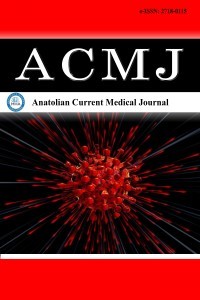1.
Ornoy A, Becker M, Weinstein-Fudim L, Ergaz Z. Diabetes during pregnancy: a maternal disease complicating the course of pregnancy with long-term deleterious effects on the offspring. A clinical review.Int J Mol Sci. 2021;22(6):2965. doi:10.3390/ijms22062965
2.
Capobianco G, Gulotta A, Tupponi G, et al. Materno-fetal and neonatal complications of diabetes in pregnancy: a retrospective study.J Clin Med. 2020;9(9):2707. doi:10.3390/jcm9092707
3.
Gebes O, Kale İ, Beser Gebes T, Muhcu M. Investigation of serum cartonectin concentrations in pregnant women with gestational diabetes mellitus; a prospective non-ınterventional cohort study. Gynecol Obstet Reprod Med. 2024;30(1):33-38. doi:10.21613/GORM.2023.1471
4.
Bayraktar B, Balıkoğlu M, Kanmaz AG. Pregnancy outcomes of women with hypoglycemia in the oral glucose tolerance test.J Gynecol Obstet Hum Reprod. 2020;49(4):101703. doi:10.1016/j.jogoh.2020.101703
5.
Bayraktar B, Balıkoğlu M, Bayraktar MG, Kanmaz AG. The effects of hyperemesis gravidarum on the oral glucose tolerance test values and gestational diabetes.Prague Med Rep. 2021;122(4):285-293. doi:10.14712/ 23362936.2021.26
6.
Minschart C, Beunen K, Benhalima K. An update on screening strategies for gestational diabetes mellitus: a narrative review.Diabetes Metab Syndr Obes. 2021;14:3047-3076. doi:10.2147/DMSO.S287121
7.
Vogel JP, Vannevel V, Robbers G, et al. Prevalence of abnormal umbilical arterial flow on Doppler ultrasound in low-risk and unselected pregnant women: a systematic review.Reprod Health. 2021;18(1):38. doi:10.1186/s12978-021-01088-w
8.
Coenen H, Braun J, Köster H, et al. Role of umbilicocerebral and cerebroplacental ratios in prediction of perinatal outcome in FGR pregnancies. Arch Gynecol Obstet. 2022;305(6):1383-1392. doi:10.1007/s00404-021-06268-4
9.
MacDonald TM, Hui L, Robinson AJ, et al. Cerebral-placental-uterine ratio as novel predictor of late fetal growth restriction: prospective cohort study. Ultrasound Obstet Gynecol. 2019;54(3):367-375. doi:10. 1002/uog.20150
10.
Wei Z, Mu M, Li M, Li J, Cui Y. Color Doppler ultrasound detection of hemodynamic changes in pregnant women with GDM and analysis of their influence on pregnancy outcomes.Am J Transl Res. 2021;13(4): 3330-3336.
11.
Aplin JD, Myers JE, Timms K, et al. Tracking placental development in health and disease. Nat Rev Endocrinol. 2020;16(9):479-494. doi:10.1038/s41574-020-0372-6
12.
Bianchi C, Taricco E, Cardellicchio M, et al. The role of obesity and gestational diabetes on placental size and fetal oxygenation. Placenta. 2021;103:59-63. doi:10.1016/j.placenta.2020.10.013
13.
Sweeting A, Wong J, Murphy HR, Ross GP. A clinical update on gestational diabetes mellitus. Endocr Rev. 2022;43(5):763-793. doi:10. 1210/endrev/bnac003
14.
Carpenter MW, Coustan DR. Criteria for screening tests for gestational diabetes.Am J Obstet Gynecol. 1982;144(7):768-773. doi:10.1016/0002-9378(82)90349-0
15.
Simental-Mendi´a LE, Rodri´guez-Mora´n M, Guerrero-Romero F. The product of fasting glucose and triglycerides as surrogate for identifying insulin resistance in apparently healthy subjects. Metab Syndr Relat Disord. 2008;6(4):299-304. doi:10.1089/met.2008.0034
16.
Pérez-Martín SM, Quintero-Prado R, Lara-Barea A, López-Tinoco C, Torrejón R, Bugatto F. Fetal cerebral three-dimensional power Doppler vascularization indices and their relationships with maternal glucose levels in pregnancies complicated with gestational diabetes.Diab Vasc Dis Res. 2022;19(1):14791641221078109. doi:10.1177/14791641221078109
17.
Steller JG, Driver C, Gumina D, et al. Doppler velocimetry discordance between paired umbilical artery vessels and clinical implications in fetal growth restriction. Am J Obstet Gynecol. 2022;227(2):285.e1-285.e7. doi: 10.1016/j.ajog.2022.03.029
18.
Lorigo M, Mariana M, Feiteiro J, Cairrao E. How is the human umbilical artery regulated? J Obstet Gynecol Res. 2018;44(7):1193-1201. doi:10. 1111/jog.13667
19.
Browne VA, Toledo-Jaldin L, Davila RD, et al. High-end arteriolar resistance limits uterine artery blood flow and restricts fetal growth in preeclampsia and gestational hypertension at high altitude. Am J Physiol Regul Integr Comp Physiol. 2011;300(5):1221-1229. doi:10.1152/ajpregu. 91046.2008
20.
Lees CC, Romero R, Stampalija T, et al. The diagnosis and management of suspected fetal growth restriction: an evidence-based approach. Am J Obstet Gynecol. 2022;226(3):366-378. doi:10.1016/j.ajog.2021.11.1357
21.
Loardi C, Fratelli N, Mazzoni G, et al. Uterine artery Doppler for the prediction of outcome in pregnancies complicated by hypertensive disorders of pregnancy. Pregnancy Hypertens. 2021;26:69-74. doi:10. 1016/j.preghy.2021.09.004
22.
Perry H, Lehmann H, Mantovani E, Thilaganathan B, Khalil A. Are maternal hemodynamic indices markers of fetal growth restriction in pregnancies with a small-for-gestational-age fetus? Ultrasound Obstet Gynecol. 2020;55(2):210-216. doi:10.1002/uog.20419
23.
Conde-Agudelo A, Villar J, Kennedy SH, et al. Predictive accuracy of cerebroplacental ratio for adverse perinatal and neurodevelopmental outcomes in suspected fetal growth restriction: systematic review and meta-analysis. Ultrasound Obstet Gynecol. 2018;52(4):430-441. doi:10. 1002/uog.19117
24.
Romero R, Kingdom J, Deter R, et al. Fetal growth: evaluation and management. Am J Obstet Gynecol. 2018;218(2S):S608. doi:10.1016/j.ajog.2018.01.010
25.
Krzyzanowski A, Kwiatek M, Geca T, et al. Modern ultrasonography of the umbilical cord: prenatal diagnosis of umbilical cord abnormalities and assessement of fetal wellbeing. Med Sci Monit. 2019;25:3170-3180. doi:10.12659/MSM.913762
26.
Cardinali F, Panunzi C, D’Antonio F, et al. Role of cerebroplacental ratio in predicting the outcome of pregnancies complicated by diabetes. Fetal Diagn Ther. 2024;51(1):55-65. doi:10.1159/000534483
27.
Papageorghiou AT, Yu CKH, Bindra R, et al. Multicenter screening for pre-eclampsia and fetal growth restriction by transvaginal uterine artery Doppler at 23 weeks of gestation. Ultrasound Obstet Gynecol. 2001;18(5):441-449. doi:10.1046/j.0960-7692.2001.00572.x
28.
Grossman L, Pariente G, Baumfeld Y, et al. Trends of changes in the specific contribution of selected risk factors for shoulder dystocia over a period of more than two decades. J Perinat Med. 2020;48(6):567-573. doi:10.1515/jpm-2019-0463
29.
Berger, H., Gagnon, R., & Sermer, M. (2019). Guideline no. 393-diabetes in pregnancy. J Obstet Gynaecol Can. 2019;41(12):1814-1825.e1. doi:10. 1016/j.jogc.2019.03.008
30.
Graupner O, Meister M, Lecker L, et al. Role of the cerebro-placental-uterine ratio in predicting adverse perinatal outcome in low-risk pregnancies at term. Arch Gynecol Obstet. 2023;308(3):849-855. doi:10. 1007/s00404-022-06733-8

